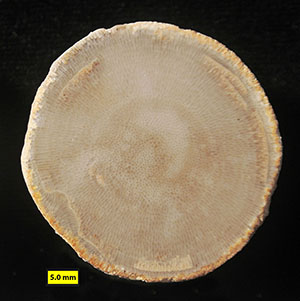Bryozoans! Everyone’s favorite fossils. When I took this course my professor mumbled at the start of this section, “I hate bryozoans. When I find them, and no one’s looking, I smash them with my hammer!” Bad form. I hope you learn to love the little critters. They can tell us much about evolution and paleoecology, and that curious state of being a colony. You can start your browsing with the Bryozoa Home Page. Many links here, including sites on both recent and fossil bryozoans. Here is the useful Wikipedia page on bryozoans. The Marine Education Society of Australasia has a good introduction to bryozoans. You also want to be sure to visit the page of my friend Paul Taylor, who is one of the top bryozoologists in the world. Here’s a page from The Netherlands on freshwater bryozoans. Some are huge. YouTube has bryozoan movies (of course!), like this one showing the action of cilia in feeding and a double feature of a bryozoan and Hydra. Oh, and I like this video of bryozoan feeding set to music. The University of Kentucky has a page of bryozoan specimen images, most without adequate scales (a mistake you will never make). In the Paleozoic, especially the Ordovician, bryozoans are very common on carbonate hardgrounds. You also will find the Dry Dredgers’ page on Cincinnatian bryozoans most useful for your field studies.
 The bryozoan Esthoniopora from the Upper Ordovician (Kukruse) of Estonia.
The bryozoan Esthoniopora from the Upper Ordovician (Kukruse) of Estonia.
Geology in the News –
Here is a recent story on Dickinsonia from the Ediacaran. Biomarkers show that it was an animal. This is not a surprising conclusion, but a cool technique.
The Japanese have landed tiny space rovers on an asteroid, and they’re starting to send back images. Postcards from the beginning of our Solar System.
This will not be news to you, but it is a fairly good accounting: What Darwin didn’t know about evolution. There are some nomenclature errors in this popular article, and poor Wallace should have been in the headline too.
Crystals of the hardy mineral zircon are giving us chemical clues about surface conditions on the earliest Earth. Maybe it wasn’t as bad as we’ve thought. There are even hints of life prior to 3.7 billion years ago.
